At some point, having a 32 core / 64 thread CPU like the AMD EPYC 7551P is simply awesome. Here is the setup. While Intel Xeon Scalable (Skylake-SP) CPUs go up to 28 cores and 56 threads each, the reality is that these top end SKUs are not for the general purpose CPU market. We covered this in our article How the Intel Xeon Platinum is a Marketing Headache. The AMD EPYC 7551P is a single-socket only part that brings into sharp focus how strong the single socket EPYC value proposition is. We wrote about this in our piece AMD EPYC’s Extraordinarily Aggressive Single Socket Mainstream Pricing. Essentially AMD is providing 32 cores for the price of an 18 core Intel Xeon Gold 6140 or CPUs in the Gold 6136/ Gold 6138 range. Intel’s chip can scale to 4 socket solutions but AMD has a specific part to address the single socket market that Intel does not match.
In today’s review, we are going to look at what makes the 7551P a tremendous value.
Key stats for the AMD EPYC 7551P: 32 cores / 64 threads, 2GHz base and 2.55GHz all core turbo and 3.0GHz max turbo boost with a whopping 64MB L3 cache. The CPU features a 180W TDP. Here is the AMD product page with the feature set. This CPU is a single socket only “P” series part. Here is the lscpu output for the processor:
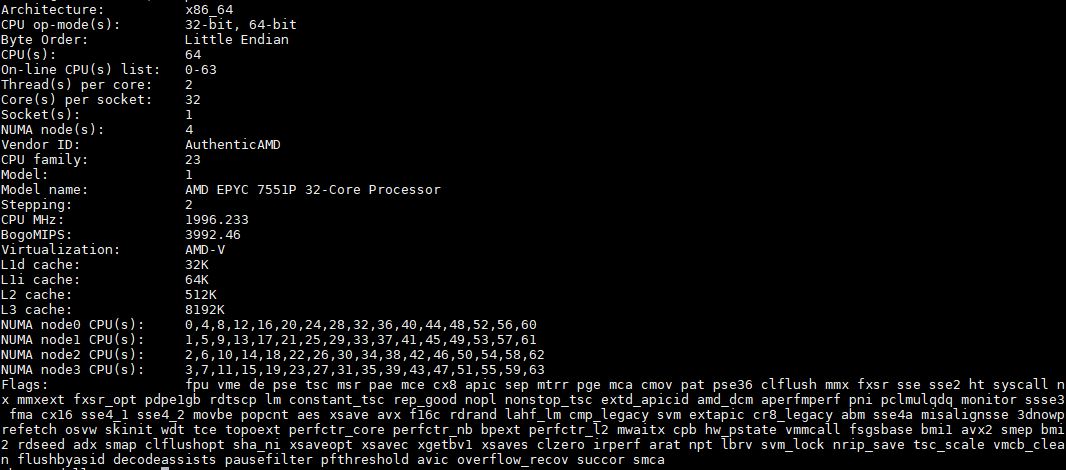
For the uninitiated in Dell EMC servers, the company’s firmware enumerates CPU threads by alternating between NUMA nodes. On most other brands of AMD EPYC 7551P servers, you would see 0-7,32-39 on NUMA node0, 8-15,40-47 for NUMA node1, and etc. We used the Dell EMC PowerEdge R7415 for this screenshot. The review will be on STH in the coming days. For the actual benchmarking, we used the same Tyan platform that we have been using for this series of reviews.
The key here is that the single socket AMD EPYC 7551P uses a four NUMA node implementation. You can read more about why in our AMD EPYC 7000 Series Architecture Overview for Non-CE or EE Majors article or learn about it in this video:
For those still unfamiliar with the AMD EPYC 7000 series here is AMD’s key value proposition bullets:
- More cores for less money. This chip retails for around $2300. Intel does not have a competing 32 core part at this time.
- More DRAM capacity. Each AMD EPYC has 8 channel memory (Xeon Scalable has 6 channel). In 16 DIMMs per socket, the AMD EPYC 7000 series can support up to 2TB of RAM per socket. The “M” series Xeon Scalable SKUs can only hit 1.5TB per socket, up from 768GB on a standard CPU, and carry a $3000 price tag for the privilege.
- 128 high speed I/O (PCIe/ SATA III) lanes in either single or dual socket mode. In single socket mode, AMD has up to 128 I/O lanes while Intel essentially has 48. You can learn more in our Single Socket AMD EPYC 7000 FAQ Answers to Common Questions.
- EPYC 7000 series is x86. You can get an Intel alternative architecture without needing major code ports or special support. Enterprise software will just work.
AMD EPYC 7000 series also has a few single socket only SKUs that have extremely low pricing. In the 32-core class, the single socket value leader is the AMD EPYC 7551P.
Next, we are going to look at our test setup and configuration before we move on to benchmarks, power consumption, and our market positioning analysis.

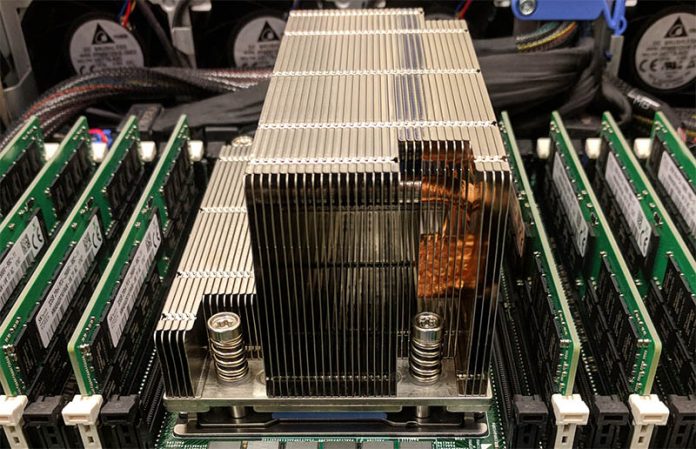
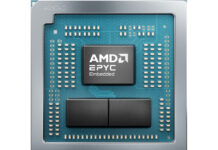
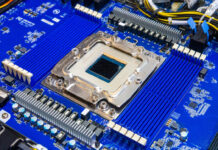
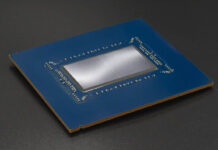
Holy hell at that c ray chart with all the EPYCs. That’s EPYC. Good job STH.
What you talked about some, but I think you can talk about more is that the $1100 cost to upgrade over the 7401P is worth it if you’ve got lots of drives and RAM in a virtualization server
Looks like a scam. Buy Intel.
“The only real competition we see on the AMD EPYC side is with the AMD EPYC 7401P.”
I think the competition are actually dual-socket EPYC 7281/7301.
Thanh – That is a good point on the dual EPYC 16 core competition. Moving to dual socket has some benefits, but costs more operationally.
I wonder why Dell enumerates CPUs in this strange way? To me it looks like they like to do SMP system from NUMA hence enforcing wrong mapping (seen that on my old HP 585 first gen. Option to enforce SMP behaviour although machine was 4 nodes numa). But w/o testing and looking into BIOS options this is hard to claim of course…
Still hoping mining/cryptonight benchmarking becomes standard test
Almost any way you look at EPYC, AMD is to be complimented for an outstanding engineering achievement!
Any thoughts on why AMD hasn’t picked up more market shares in DC? I am guessing because the lead time is way longer?
Or are they all waiting for Zen2?